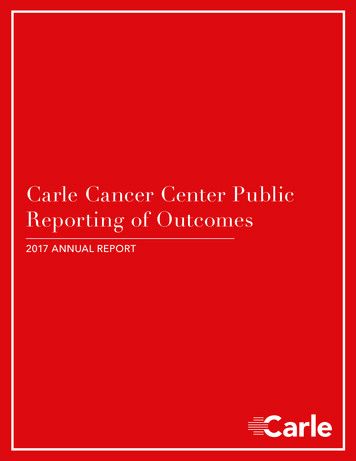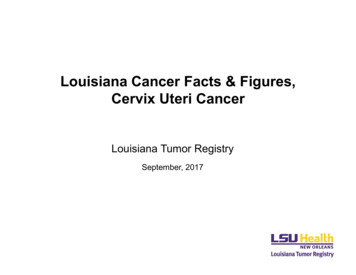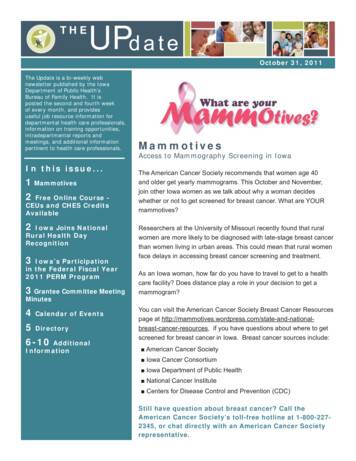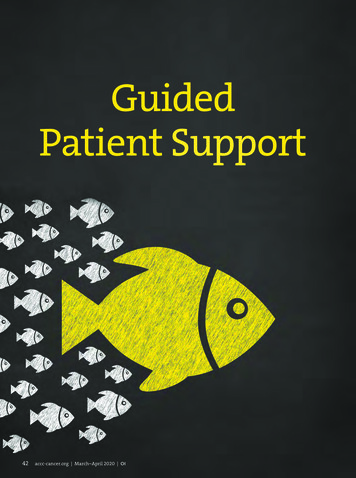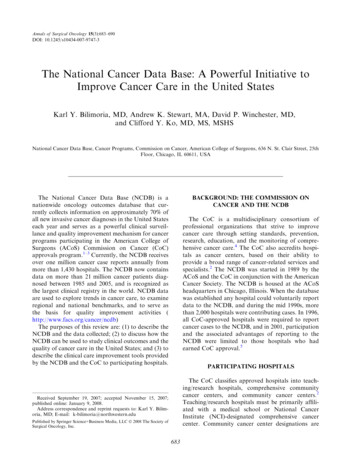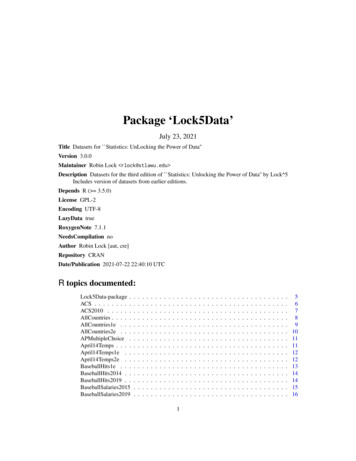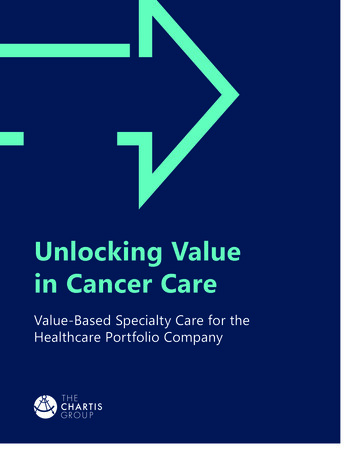
Transcription
Unlocking Valuein Cancer CareValue-Based Specialty Care for theHealthcare Portfolio Company
Unlocking Value in Cancer Care Value-Based Specialty Care for the Healthcare Portfolio CompanyThe Second Act for VBC Has Started—and It’s All About Specialty CareOncology is emerging as an investor favorite in thespecialty investment space because a unique set offeatures makes cancer care attractive forvalue-based transformation.To date, the value-based investment space has been hyper-focusedon primary care, including full-risk Medicare Advantage (MA)primary care platforms like Oak Street Health and Cano Health;pure “pay-vider” platforms like Humana’s CenterWell/Convivaand Anthem’s CareMore; risk-affiliate platforms like Agilon; andvalue-based payers like Oscar and Clover. These value-based care(VBC) archetypes all play different variations of the same theme—empowering owned or partnered primary care physician (PCP)practices to flip to MA risk through innovative care management,technology, and contracting expertise. The “risk-on” propositionhas resonated with primary care physicians due to their challengingpractice economics and span of influence on MA patient utilization.As investors look to the next chapter of VBC, specialties likeoncology, nephrology, neurology, and orthopedics are emerging ascore portfolio priorities. This “second act” for VBC is a function ofconcentrated MA spend in specialty care, and interest from payersand management services organizations (MSOs) in transferringrisk to high-value specialists who can manage chronic conditionsand acute, high-cost episodes. In this briefing, we explore theunique features that position oncology well for value-basedtransformation, discussing the status of value-based contractingin oncology and profiling investment archetypes frequently underportfolio company consideration.Value-Based Care Is Core tothe Value-Creation PlaybookThe evolving value creationstrategy for portfolio companiesshould take into considerationthree key areas: health systemand payer partnerships, scalableoperational architecture, and thehealthcare industry’s quest to movetoward value-based care (VBC).The value-based investment thesisis bolstered by significant tailwindsfor a transition to risk in senior care.The U.S. population is growingand aging into Medicare eligibility,with Medicare Advantage (MA)penetration estimated by Chartis toreach 50% by as early as 2025.¹These demographic trends,coupled with intense interestfrom payers to offload risk andstabilize margins, has producedan investment space awash inMA global capitation players—evidenced by the nearly 60billion combined market value ofnew VBC market entrants and theemergence of funds like Valtruis(WCAS) focused exclusively on thevalue-based space.²Value in Cancer Care Is Winnable, Though Its Path Is WindingAs investors evaluate the VBC oncology thesis, the opportunity is immense. Cancer incidence is growing precipitously,fueled by an aging U.S. population. Total cancer cases are expected to top 2.3 million by 2030, driving over 250 billion inhealthcare expense.³ The care ecosystem is rife with disutility, a function of buy-and-bill drug incentives (and broader feefor-service hazards), multimodal episodes that often lack central coordination and care management, andavoidable admissions.With this backdrop, the theory of the VBC case is straightforward: a risk-on oncology practice should be able tomeaningfully bend the cancer cost curve through evidence-based practice and a high-touch, value-oriented care model.So why have leading value-based cancer practices been slow to emerge?1
Unlocking Value in Cancer Care Value-Based Specialty Care for the Healthcare Portfolio CompanyMany features that make cancer attractive for investment also make it obstinate when it comes to value-basedtransformation. These include provider scarcity; risk-adoption barriers like disease heterogeneity, span of control, andpractice economics; and structural deficiencies in the care model. In various forms, each of these obstacles is beingaddressed by innovative platforms, explored below through three lenses:Aligning ProvidersEnabling Smarter RiskUnlocking More ValueALIGNING PROVIDERSSecuring medical oncologists for VBC is the most acute challenge for investor-backed platforms. Approximately 65% to70% of medical oncologists are aligned with community or academic hospitals, the result of a decade-long integrationtrajectory enabled by site of service differentials and 340B purchasing discounts (Figure 1). The remainder of themarketplace is highly consolidated, with less than 2% of practices representing nearly 10% of oncologists—inclusiveof aggregator platforms like US Oncology (McKesson), One Oncology (General Atlantic), Integrated Oncology Network(Silver Oak), and GenesisCare (KKR). The remaining 22% of oncologists belong to physician-owned independent practicesthat represent a highly fragmented and distributed cohort, with an average practice size of just 3.6 physicians.⁴ Takentogether, these dynamics represent a significant barrier to entry for aspiring value-based provider organizations.Figure 1: National Hematology/Oncology Workforce DistributionMSO Partnered2%Physician Owned39%22%Physician OwnedAcademic15%41%AcademicHospital44%Percent of Practices(N 1,598)9%28%MSO PartneredHospitalPercent of Hem/Oncs(N 12,407)Source: Chartis analysis of Medicare Physician Compare Database for hematology/oncology2
Unlocking Value in Cancer Care Value-Based Specialty Care for the Healthcare Portfolio CompanyWhile market scarcity has driven high acquisition multiples for oncology practices and crowded out some would-beaggregators, it has also propelled innovation in alignment models conducive to VBC:zzzzExtraction: Large-scale hospital practice extraction and “acqui-hire” are increasingly common, as seen in Memphiswith One Oncology and The West Clinic (formerly aligned with Methodist Hospital), and in Baton Rouge with OneOncology’s recently announced partnership with Mary Bird Perkins Cancer Center (formerly partnered with Our Ladyof the Lake Hospital).5,6De Novo Build: Organizations like The Oncology Institute of Hope and Innovation (TOI) are purpose-building,value-based practices in small-format, de novo settings like those recently opened in St. Petersburg, Florida andTucson, Arizona. TOI represents perhaps the most disruptive entrant given its value-native care model, experiencewith risk-based contracting in legacy markets, and growth capital unlocked through a recent SPAC public offeringwith Deerfield Management.⁷Multi-Partner: Alliance Oncology, recently acquired by Akumin Inc. for 820 million, has pursued an alternativepath by partnering directly with hospitals and physician groups in cancer care. These include modality-specificjoint ventures, like the radiation therapy center partnership announced with SCL Health in Denver, Colorado. Theyalso include vertically integrated projects like the Singing River Cancer Center in Florence, Alabama, which housesoncologic surgeons, Alliance’s radiation therapy, Clearview Cancer Institute medical oncologists, and mammographythrough Helen Keller Hospital.⁸Pure “Pay-Vider”: While not ubiquitous, we have begun to see examples of wholly owned, payer-managed oncologypractices. Optum has been the pioneer in this space. OptumCare Cancer Center’s seven locations in Las Vegas offerthe full continuum of ambulatory care—chemotherapy, radiation, ambulatory surgery, etc. It remains to be seenwhether this model will take hold amongst payers with the same vigor as owned, risk-bearing PCP networks.Given the pivotal role of the oncologist, we expect to continue seeing creative destruction and new models of oncologyalignment, with VBC as an explicit design objective.ENABLING SMARTER RISKTwo-sided risk has been a de minimis component of contemporary alternative payment models (APMs) for cancer care.Examples abound of fee-for-service (FFS) hybrids, including bonuses for pathway compliance, per-member-per-monthpayments (PMPMs) to support care navigation, and retrospective (one-sided) shared saving payments. The most visibleof these hybrids is Center for Medicare and Medicaid Innovation’s (CMMI) Oncology Care Model (OCM), a five-year pilotprogram that uses FFS reimbursement with nominal care coordination payments and shared savings eligibility on sixmonth, episodic-based, total cost of care targets.⁹ Results from the OCM and other APMs have been underwhelming(e.g., 315 million OCM loss), not for a lack of addressable value levers, but for these inherent complexities in cancer care:zHeterogeneity: Cancer represents hundreds of diseases, resulting in natural spend variability amongst practicesand challenges to risk-based contracting. This issue is being tackled by technology companies like COTA Healthcare,recently funded with a 34 million Series D led by Baptist Health South Florida and ONC Capital.10 COTA’s platformleverages a “barcode” to identify patients by cancer histology, stage, and genomic signature, enabling datascientists to better cohort patients and enable bundled payment design (e.g., Hackensack/Horizon BCBS’ bundledpayment model).The heterogeneity issue is also being addressed in the next generation of APMs, like CMMI’s Oncology Care FirstModel (OCFM) through improved stratification by cancer type in total cost of care targets used for its two-sidedrisk model.11 Investor-based platforms should learn from the OCM’s deficiencies, look to the OCFM’s blueprint, andconfirm that any contemplated risk-based contracting has sufficient tumor-level specificity.3
Unlocking Value in Cancer Care Value-Based Specialty Care for the Healthcare Portfolio CompanyzSpan of Control: Oncology is highly multidisciplinary and often lacks a single specialist in the value chain withcomplete visibility and utilization influence. Patients frequently traverse unaffiliated screening, diagnostic, procedural,medical oncology, and radiotherapy practices, creating a splintered care continuum that complicates full capitation.Span of control is being addressed in two ways, first through vertical integration of the participating cancerspecialists—as seen in places like Naples, Florida, where GenesisCare has acquired urologists, breast surgeons, andgynecologic oncologists, and in many US Oncology markets like Minneapolis and Dallas, where practices now includesurgery, hematology/oncology, and radiation oncology. These fully integrated models of care, covering diagnosisthrough all major cancer modalities, have the theoretical advantage if the market moves toward global MA capitation.The second approach to solving for span of control is narrowing the risk corridor, either by focusing on a discreteepisode within the cancer continuum, or on a narrow disease subset (Figure 2). The former is the model for CMMI’sOCM, with 6-month total cost of care episodes triggered at initial infusion, and the upcoming Radiation OncologyAPM with prospective bundles in radiotherapy for 15 different cancer types. A fully bundled payment narrowed bydisease type has been deployed by Memorial Sloan Kettering Cancer Center (MSKCC) and Carrum Health for twoyear treatment bundles in non-metastatic breast and thyroid cancer, and by Regional Cancer Care Associates (RCCA)and Horizon BCBS exclusively in breast cancer.12,13zPractice Economics: The final hurdle to risk is the basic economic profile of an oncology practice. At a median salaryof 481,000, the specialty is well compensated, creating a friction point with models that introduce downside risk.14Of that compensation, approximately 80% is generated by margin on drug buy-and-bill, meaning income is dilutedwhen choosing the cheapest alternative amongst similarly effective chemotherapy regimens. Without compellingshared savings constructs, oncologists and payers have been left in perpetual struggle over drug selection,adjudicated through onerous pre-authorization requirements and frequent delays to patient care.Figure 2: APMs in Cancer Value ChainFULLY BUNDLEDPAYMENTSPCP & Screening Abnormal Findings Screening (e.g.,mammogram) EmergencyMSKCC & Carum (non-metastatic breast and thyroid) RCCA & Horizon (breast)SpecialistsCancer Surgery Gastroenterology General OB/GYN Colorectal Radiology Pulmonology Surgeons BreastSurvivorshipMedicalOncology ThoracicRadiationOncology GYN OncologyProgression HPB UrologyEPISODIC PMPM SHARED SAVINGSCMMI: OCMEPISODIC BUNDLED PAYMENT CMMI: RO-APM4
Unlocking Value in Cancer Care Value-Based Specialty Care for the Healthcare Portfolio CompanyThe challenge is compounded by the price of therapeutics, with median prices for newly approved cancer drugsincreasing from 1,932 in 1995 to 1999 to nearly 15,000 in 2015 to 2019, driven in part by blockbuster TKI inhibitorsand immune effector class therapies (e.g., CAR-T) that cost hundreds of thousands of dollars.15 The price tag on thesedrugs and the frequency at which they are emerging creates an actuarial nightmare for practices taking risk on totalcost of care or bundled payments. The OCFM attempts to solve for this issue through a partially capitated paymentfor evaluation and management and infusion administration, while deploying a more robust adjustment mechanismfor novel therapies when calculating performance versus historical drug cost targets.Successfully transitioning to risk will require investor platforms to solve for provider incentives and cost targets thatadequately adjust for expensive, emerging classes of drugs. The complexity of this undertaking explains why manypractices are seeking partners with core competency in risk-based contracting and oncology decision support,including businesses like Eviti (NantHealth), AIM Specialty Health, and New Century Health (Evolent Health). Weexpect these benefit management platforms to continue expanding their reach and capability in the value-basedcancer space.UNLOCKING MORE VALUEIf oncologists can be sourced and risk-based contracting can align stakeholder interests, the real test for oncology VBC ispractice transformation required to generate value. The levers of value are generally accepted to be pathway compliance,formulary management, early palliation and symptom management, ED and IP avoidance, and care transitions. A host ofvalue-based platforms are seeking to target these domains, including the following categories:zzzCommercial Pathways: Oncology pathways have carved out a distinct role in enabling VBC, proliferating broadlythrough platforms like Clinical Path (formerly Via Oncology), Clear Value Plus (US Oncology/Ontada), and DanaFarber Clinical Pathways (DFCI/Philips). While primarily focused on promoting adherence to evidence-based practice,pathways have also been adopted by Anthem’s Cancer Care Quality Program, UnitedHealthcare’s Cancer TherapyPathways Program, and Blue Cross Blue Shield of North Carolina, to encourage cost-effective selection amongstclinically equivalent regimens. In a 12-month pilot, UHC demonstrated 20% savings relative to controls whendeploying its pathways with Eviti (NantHealth).16 We expect pathway adoption to accelerate and begin to expandbeyond medical oncology to adjacent oncologic specialties in the continuum.Oncology Medical Homes: Numerous payer-sponsored medical home models have emerged, grounded in valuederived from closer monitoring and enhanced care team access during active cancer treatment. These programslike TN Oncology/BCBS’s care coordination incentive model and the Cigna Collaborative Care for Oncology supportinfrastructure needed for remote monitoring, 24/7 patient access and symptom management, and distress screening.Companies have emerged to serve these functional requirements, including the Appriss Health (Clearlake CapitalGroup) PatientPing platform that sends real-time notifications to the care team when patients experience a care event(e.g., admission), and TapCloud, an AI-driven patient connectivity tool that collects information on adherence, SDOHissues, and cancer patient well-being.Digitally Enabled Coordination: A new class of companies is also emerging to address care coordination deficitswith digitally enabled care management models. These platforms move upstream to payers, offering their membersimmediate access to a care navigator when faced with a cancer diagnosis. Thyme Care, recently funded by AndreesenHorowitz with 22 million, is a recent entrant that brings its tech-enabled navigation model to Clover’s MA membersacross New Jersey.17 A similar model is available to payers through Jasper Health (Redesign Health and 7wireVentures) via a “smart planner” for cancer care, designed to connect patients with certified oncology social workersand triage symptoms on a timely basis. These solutions serve a critical coordination role but also enable site of caresteerage and responsible care transitions in palliative and end of life episodes.5
Oncology Is Set to Take Center StageWe expect to see massive investment in value-based specialty care in the near future. Investorbacked platforms will continue to iterate and overcome traditional roadblocks—securing providercapacity, designing smarter models of risk, and enabling care transformation that unlocks lastingvalue for patients, providers, and payers. And as this exciting “second act” of VBC seeks outspecialties in need of transformation, we expect oncology to take center stage.AuthorsRyan LangdaleDirectorrlangdale@chartis.comSri ManiDirectorsmani@chartis.com
Unlocking Value in Cancer Care Value-Based Specialty Care for the Healthcare Portfolio CompanySOURCES1.The Chartis Group, “As MA Enrollment Booms, Healthcare Entities Need to Plan Around Key Trends,” March 29, -around-keytrends2.Pringle, Sarah, “Value-based care emerges as must-have for investors.” PE Hub, November 21, 20213.American Association of Cancer Research, “Cancer Care Costs in the United States by 2030,” June 10, 2020, e-projected-to-exceed245-billion-by-2030/4.Chartis analysis of Medicare Physician Compare Database for orthwest-alabama/9.Evaluation of the Oncology Care Model: Performance Periods 1-5, cm-evaluation-pp1-510. wth-capital-and-triples-data-access/11. Oncology Care First Model: Informal Request for Information, .pdf12. o-launch-bundled-cancer-care/13. eakingpatient14. MGMA Data Dive, 2020 report of 2019 total compensation for Hematology/Oncology15. Drug Pricing Lab, tracker/16. Newcomer, Lee, et al, “Transforming Prior Authorization to Decision Support,” JCO Oncology Practice, October 18, 201617. rough-Their-Cancer-Journey7
About The Chartis GroupThe Chartis Group (Chartis) provides comprehensive advisory services and analytics to the healthcare industry. It brings criticalthinking and deep industry experience paired with cutting-edge data, analytics, and technology to deliver #NextIntelligence. Withan unparalleled depth of expertise in strategic planning, performance excellence, health analytics, informatics and technology, digitaland emerging technologies, clinical quality and operations, and strategic communications, Chartis helps leading academic medicalcenters, integrated delivery networks, children’s hospitals and healthcare service organizations achieve transformative results andbuild a healthier world. Chartis has offices in Atlanta, Boston, Chicago, New York, Minneapolis, and San Francisco.Connect with us: www.chartis.com LinkedIn Twitter YouTube 2022 The Chartis Group, LLC. All rights reserved. This content draws on the research and experience of Chartis consultants and othersources. It is for general information purposes only and should not be used as a substitute for consultation with professional advisors.
Unlocking Value in Cancer Care Value-Based pecialty Care or the ealthcare Portfolio Company 4 z Span of Control: Oncology is highly multidisciplinary and often lacks a single specialist in the value chain with complete visibility and utilization influence. Patients frequently traverse unaffiliated screening, diagnostic, procedural,



